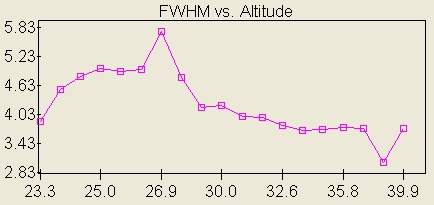M101 with supernova, October 16 - 2011

Conditions: very nice weather - weak wind, haze level low, no clouds; gibbous moon
Setup: AstroTech 8" f/8 RC telescope , DF-2 focusser, AO8 guider with MOAG and remote guide head, CFW8, ST10XE (0.86"/pixel), Takahashi EM-200 mount (image)
Aquisition: guiding at 6.5Hz, 200minutes total exposure time through R,G,B filters (600sec subexposures)
The supernova in nearby M101 has been described as 'one in a generation'. The imaging conditions for this shot were not the best since M101's altitude was just 40 degrees at twilight and decreasing.
When my last subexposure ended this had decreased to just 23 degrees; hence my data suffers from increasing atmospheric reddening and blurring. To compensate for this I did the imaging sequence as B-G-R, since the
blue channel is most affected by our atmosphere and red the least. Still, the subexposure FWHM changed quite a lot, as shown below (in arcseconds):

To compensate for this I blurred the B and G channels slightly to match the R. The final image is a LRGB composite with L synthesized from the RGB data and sharpened slightly. I am trying to learn more
about Photoshop processing, and this image has suffered some of the consequences (levels, curves, micro-contrast adjustment, decreased star bloating). The image also suffers a bit from
star elongation, especially in the uncropped version (look here). I think that this is due to imperfect collimation of the telescope.
Here's my main page where you can see more of the pictures I have taken so far.
Comments greatly appreciated! (mikael@leif.org)

